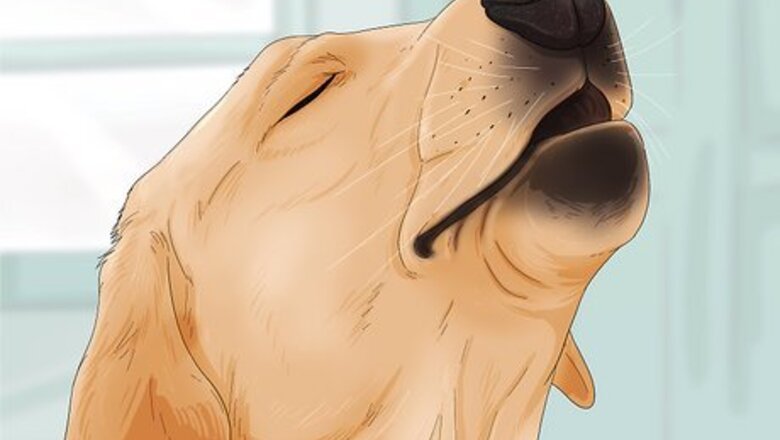
views
- A dog in pain might avoid touch or withdraw from interaction, eat and drink less, sleep more or less than normal, or go to the bathroom indoors.
- They may also be limping, pacing, changing their posture, whining or crying, or showing sudden aggressive behavior.
- Call your vet immediately if you notice any signs of pain in your dog, as they’ll be able to help determine what’s wrong.
Whining or crying
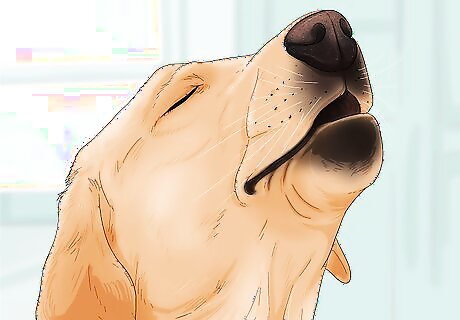
Unusual vocalizations could be a dog’s way of saying, “I’m hurt.” Unlike us, dogs can’t verbally say when or where they’re hurt, but they can cry out. Notice if your dog has started moaning, whimpering, yipping, or howling, especially when they’re touched or doing a specific activity. Pay attention to what's happening around your pup when they cry out. Locating the area or cause of the cry can help you and a vet understand the dog’s pain and help them feel better.
Avoiding touch
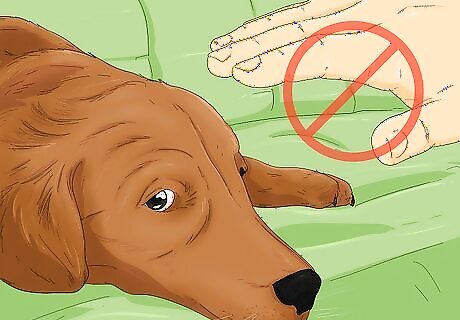
Hiding or shying away from contact is a common sign of pain in dogs. Many dogs don’t want to be touched when they’re in pain, especially if a specific area of their body is hurting. Your pup loves you, but they may duck or move away from your touch because being pet might be painful. This could be a sign of a physical injury in the joint or skin tenderness, but it could also be a sign of depressive behavior. Bring your dog to the vet if this is unusual behavior. They’ll be able to give a physical examination and help your pup feel as good as new.
Limping

An injured dog may limp to avoid causing more pain in a leg. Watch how your dog walks. Are they leaning to one side? Do they hop or lift one foot? If a leg is causing a dog pain, they’re less likely to use it, so they’ll try their best not to walk on it. This could be a sign of a broken bone, strain, or arthritic condition. Drive your dog to a veterinary clinic if their limping is persistent. With a few X-rays and an examination, a vet can help you find out what’s wrong.
Hesitating to stand, jump, or use stairs
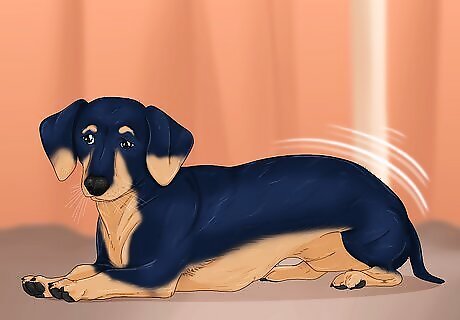
In an attempt to stop the pain, injured dogs may be reluctant to move. Mobility changes are tell-tale signs something’s going on with your pup. Maybe they have trouble getting up and down or are hesitant to race down the stairs. Immobility or hesitancy could be a sign of pain in many different areas: hip, knee, paw, shoulder, back, and/or stomach. Try filming a video of your pup to send to your vet, so they can see how they’re walking. This way, your vet can tell you if you need to go to the clinic for care or can help your pup at home.
Sitting or walking differently

A tucked tail, arched back, or random bow could be a sign of pain. You know your dog’s behavior and movements better than anyone. Look to see if they’re standing, sitting, and/or laying differently. Depending on the location of the pain, a dog might take a bowing position for relief—butt in the air, legs on the ground, and stretching their abdomen. More subtle signs could also be a tuck or lack of wagging the tail or a sunken or arched back. Every dog's anatomy and stance are different, so even the slightest change could determine where your dog is hurting—tail, back, leg, paw, neck, etc.
Being restless
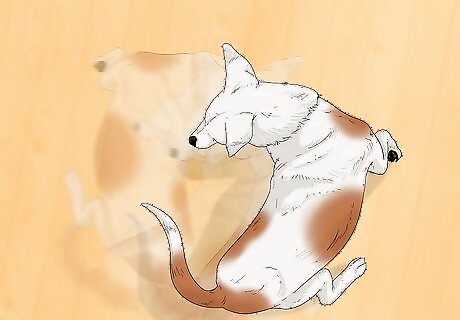
Pacing or readjusting positions frequently are signs of pain in dogs. If your dog is hurt, they may not be able to get comfortable. This could cause antsy behavior or them moving around a lot. They’re not trying to be loud or annoying; they just want to find a comfortable position. This could be a sign of many injuries that are painful to put pressure on, like strains, bruises, broken bones, etc. Try sitting down with your pup and seeing if they’ll lay down with you. If not, call your vet for help.
Showing aggression
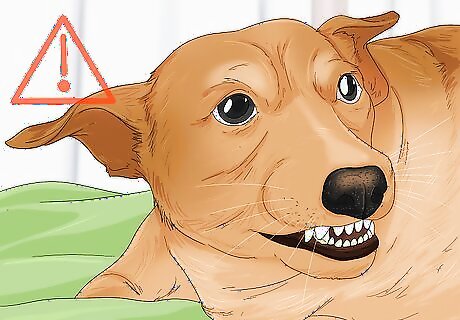
If a dog’s in pain, they may nip or snap at you or other animals. Sometimes even the sweetest dogs can turn hostile because of pain. If your furry friend isn’t known to growl, bite, or show their teeth and is doing so without cause, it may be because pain is affecting their mood. Dogs may also bite or growl if they're touched or moved into a painful position. This is a natural response, and your dog doesn’t mean to bring you harm, but that’s why it’s important to contact a vet for help.
Eating less
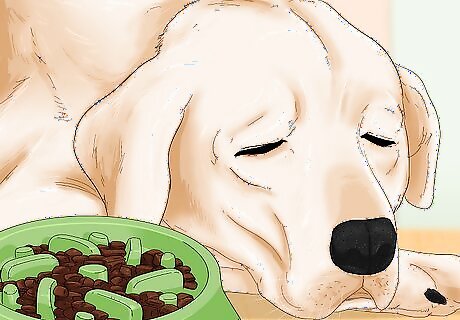
A dog in pain may eat less or not at all. If your pup suddenly has an aversion to food or doesn’t come running when you fill their dish, it may be because of pain or an underlying illness. Try tempting your dog to eat by pouring chicken broth over their food or switching their type of food. If they still don’t eat after 8 to 12 hours, contact your vet. A fluctuating appetite alone could be a sign of emotional stress, but when paired with vomiting and/or diarrhea, it could be a more serious issue. Try not to worry too much too soon. Monitor their behavior and take notes of when they do eat and use the bathroom. If your dog is eating more slowly or dropping food while they eat, they could be experiencing tooth or mouth pain.
Sleeping more or less than usual
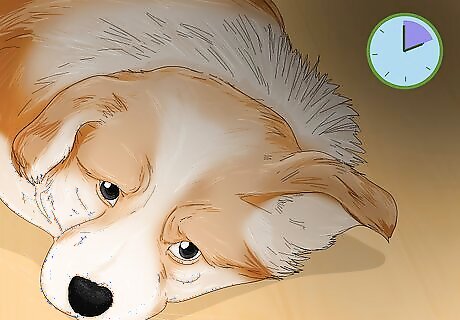
If a dog’s in pain, they may find it hard to get comfortable at night. Most dogs have a regular sleep schedule they naturally stick to, but their schedule may be all over the place if they’re hurt. They may sleep less at night because they’re trying to find a comfortable position, and as a result, they may sleep more during the day. This is often a sign of joint or arthritic pain as the lack of movement while trying to sleep can cause a dog more pain.
Peeing and pooping indoors
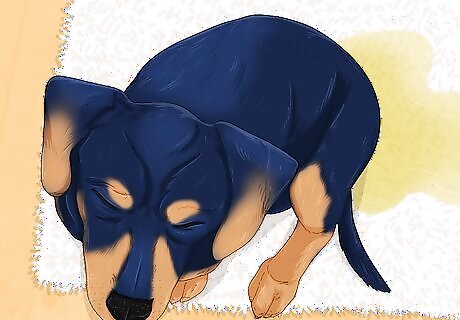
Urinary infections and chronic pain can cause dogs to pee in the house. If your dog’s in constant pain, they may forget their potty training. They’re not trying to be naughty; they physically can’t hold it until they go outside. Watch your pup closely to monitor when, how, and where they go to the bathroom and note any unusual behavior. Your dog may have a different posture when urinating if they’re experiencing pain in their stomach, back, legs, hips, or paws. Pay attention to the color and size of your dog’s poop. A healthy stool is shaped like a log and has a chocolate brown color.
Panting heavily
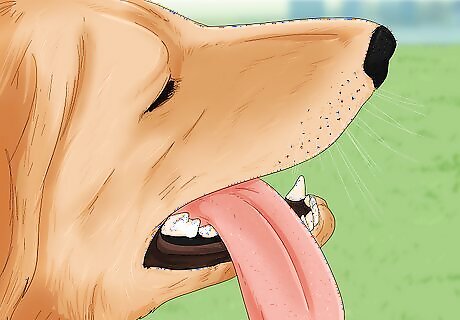
A dog’s breathing pattern often quickens if they’re in pain. Dogs naturally pant to cool themselves down—it’s their version of sweating—but panting excessively could be a sign of concern. If your dog’s breaths seem to quicken without cause (they’re not in a hot place or haven’t done a strenuous activity), they may be trying to breathe through the pain. Panting is often paired with other signs of pain or signifies that the dog is stressed or anxious. While you contact a vet, pet and console your pup if they let you. Gentle pats and soothing phrases can let them know you’re there for them.
Swelling or irritated eyes
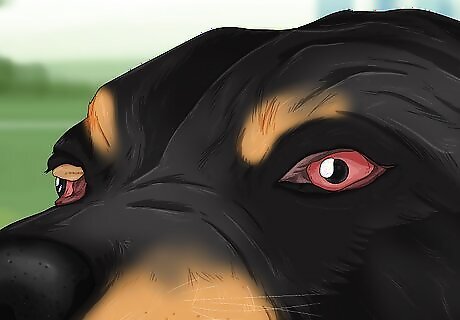
Squinting, redness, cloudiness, or dilation might result from eye pain. Believe it or not, a dog’s eyes can tell you a lot about the pain they may be experiencing. Take a close look at your pup’s eyes. Is there any visible redness, swelling, or cloudiness? Is the pupil larger than normal? Is there a discharge around the eye? If you notice any of these signs, contact your vet for further instructions. These could be signs of an infection, injury, or underlying disease. Give your pup plenty of treats while you check their eyes to keep them happy and still.



















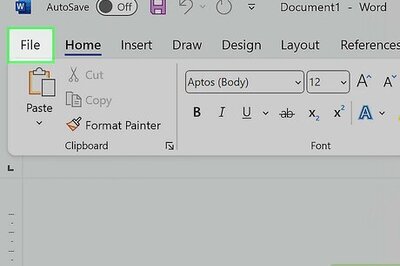
Comments
0 comment